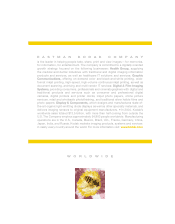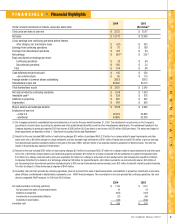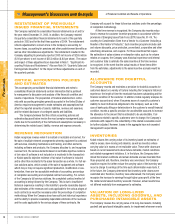Kodak 2004 Annual Report Download - page 10
Download and view the complete annual report
Please find page 10 of the 2004 Kodak annual report below. You can navigate through the pages in the report by either clicking on the pages listed below, or by using the keyword search tool below to find specific information within the annual report.
Financials
8
EASTMAN KODAK COMPANY
WARRANTY OBLIGATIONS
Management estimates expected product failure rates, material usage and
service costs in the development of its warranty obligations. At the time
revenue is recognized, the Company provides for the estimated costs of its
warranties as a reduction of revenue. Actual results have not differed ma-
terially from management’s estimates. In the event that the actual results
of these items differ from the estimates, an adjustment to the warranty
obligation would be recorded.
PENSION AND POSTRETIREMENT
BENEFITS
Kodak’s defi ned benefi t pension and other postretirement benefi t costs and
obligations are dependent on assumptions used by actuaries in calculating
such amounts. These assumptions, which are reviewed annually by the
Company, include the discount rate, long-term expected rate of return on
plan assets, salary growth, healthcare cost trend rate and other economic
and demographic factors. The Company bases the discount rate as-
sumption for its signifi cant plans on the estimated rate at which annuity
contracts could be purchased to discharge the pension benefi t obligation.
In estimating that rate, the Company looks to the AA-rated corporate
long-term bond yield rate in the respective country as of the last day of the
year in the Company’s reporting period as a guide. The long-term expected
rate of return on plan assets is based on a combination of formal asset
and liability studies, historical results of the portfolio, and management’s
expectation as to future returns that are expected to be realized over the
estimated remaining life of the plan liabilities that will be funded with the
plan assets. The salary growth assumptions are determined based on the
Company’s long-term actual experience and future and near-term outlook.
The healthcare cost trend rate assumptions are based on historical cost
and payment data, the near-term outlook, and an assessment of the likely
long-term trends.
The Company reviews its expected long-term rate of return on plan
asset (EROA) assumption annually for the Kodak Retirement Income
Plan (KRIP). To facilitate this review, every three years, or when market
conditions change materially, the Company undertakes a new asset and
liability study to reaffi rm the current asset allocation and the related EROA
assumption. The Company’s investment consulting fi rm completed a study
(the Study) in September 2002, which led to several asset allocation shifts
and a decrease in the EROA from 9.5% for the year ended December
31, 2002 to 9.0% for the years ended December 31, 2003 and 2004. In
March 2005, a new asset and liability modeling study has been completed
and the EROA for 2005 will remain at 9.0%. Given the decrease in the
discount rate of 25 basis points from 6.0% for 2004 to 5.75% for 2005 and
increased recognition of unrecognized losses in accordance with Statement
of Financial Accounting Standards (SFAS) No. 87, “Employers’ Account-
ing for Pensions,” total pension income from continuing operations for the
major funded and unfunded defi ned benefi t plans in the U.S. is expected
to decrease from $3 million in 2004 to refl ect an expense of $1 million
in 2005. Pension expense from continuing operations in the Company’s
non-U.S. plans is projected to increase from $98 million in 2004 to $104
million in 2005. Additionally, due in part to the decrease in the discount
rate from 6.0% for 2004 to 5.75% for 2005 and increased amortization
expense relating to the unrecognized actuarial loss, the Company expects
the cost of its most signifi cant postretirement benefi t plan, the U.S. plan,
to approximate $200 million in 2005, as compared with $103 million and
$238 million for 2004 and 2003, respectively. These estimates have been
incorporated into the Company’s earnings outlook for 2005.
Actual results that differ from our assumptions are recorded as unrec-
ognized gains and losses and are amortized to earnings over the estimated
future service period of the plan participants to the extent such total net
recognized gains and losses exceed 10% of the greater of the plan’s pro-
jected benefi t obligation or the market-related value of assets. Signifi cant
differences in actual experience or signifi cant changes in future assump-
tions would affect the Company’s pension and postretirement benefi t costs
and obligations.
In accordance with the guidance under SFAS No. 87, the Company is
required to record an additional minimum pension liability in its Consoli-
dated Statement of Financial Position that is at least equal to the unfunded
accumulated benefi t obligation of its defi ned benefi t pension plans. During
2004, due to the performance of the global equity markets, combined with
decreasing discount rates in 2004, the Company increased its additional
minimum pension liability for its major defi ned benefi t plans by $90 million
and recorded a corresponding charge to accumulated other comprehensive
income (a component of shareholders’ equity) of $61 million, net of taxes
of $29 million. If the global equity markets’ performance improves and
discount rates stabilize or improve in future periods, the Company may be
in a position to reduce its additional minimum pension liability and reverse
the corresponding charges to shareholders’ equity. Conversely, if the global
equity markets’ performance and discount rates continue to decline in
future periods, the Company may be required to increase its additional
minimum pension liability and record additional charges to shareholders’
equity. To mitigate the increase in its additional minimum pension liability
and additional charges to shareholders’ equity, the Company may elect to
fund a particular plan or plans on a case-by-case basis.
ENVIRONMENTAL COMMITMENTS
Environmental liabilities are accrued based on estimates of known envi-
ronmental remediation exposures. The liabilities include accruals for sites
owned by Kodak, sites formerly owned by Kodak, and other third party
sites where Kodak was designated as a potentially responsible party (PRP).
The amounts accrued for such sites are based on these estimates, which
are determined using the ASTM Standard E 2137-01, “Standard Guide for
Estimating Monetary Costs and Liabilities for Environmental Matters.” The
overall method includes the use of a probabilistic model that forecasts a
range of cost estimates for the remediation required at individual sites. The
Company’s estimate includes equipment and operating costs for remedia-
tion and long-term monitoring of the sites. Such estimates may be affected
by changing determinations of what constitutes an environmental liability or
an acceptable level of remediation. Kodak’s estimate of its environmental li-
abilities may also change if the proposals to regulatory agencies for desired
methods and outcomes of remediation are viewed as not acceptable, or
additional exposures are identifi ed. The Company has an ongoing monitor-
ing and identifi cation process to assess how activities, with respect to the
known exposures, are progressing against the accrued cost estimates,
as well as to identify other potential remediation sites that are presently
unknown.























